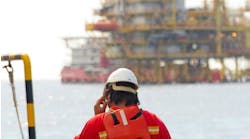Floatover installations gaining momentum in the Arabian Gulf
Fixed platforms are the most prevalent type of offshore structure that Saudi Aramco installs in the Arabian Gulf for crude oil and gas production.
Offshore platforms are structurally divided into topsides (super-structure above sea) and jacket (sub-structure below sea). These elements are generally fabricated separately, meaning that the integration of the topsides and the corresponding substructure becomes a significant engineering challenge in platform construction.
In recent years, Saudi Aramco has initiated the floatover method for platform integration as it is more cost-effective for heavier topsides. The company’s recent successful demonstration of the floatover method of platform integration could provide a model for others in the industry who are facing the challenge of heavier topsides installation.
Platform integration
In the offshore oil and gas industry, the platform construction phases are:
1. Onshore fabrication
2. Load-out on to transportation barge
3. Platform integration at offshore site
4. Hook-up and commissioning.
All the offshore modules are fabricated at an onshore yard located near the port. Load-out is when the module is moved to the transportation vessel with trailers. The fabrication yard is near a port in order to reduce the load-out distance. Jacket and topsides, which are fabricated as separate modules, are integrated as a platform offshore. The last step before handing over the platform is to hook-up the piping, electrical, and instrumentation equipment, and perform the commissioning. Platform commissioning is a process to ensure all the components, process, safety, and overall systems operate as per the project requirements.
Lifting is the traditional method of platform integration. A floating crane vessel lifts and positions the topsides on the jacket structure at the offshore site. This is the preferred method and remains a highly efficient method for structure modules weighing less than 3,500 metric tons (3,858 tons).
In an ideal scenario, there would be a crane barge available with the capacity to lift the topsides in one piece in order to avoid offshore hook-up work. The marine lifting operation requires engineering and planning, and the complexity increases further with the increase in size and weight of the topsides.
Because of these limitations, there has been a strong incentive for some type of system that could lift the heaviest deck offshore at reduced cost; and to fabricate and install a topsides in one module rather than multiple modules. A successful solution would significantly save offshore hook-up, commissioning, and transportation time.
For heavy superstructures like tie-in topsides, the lift method is not feasible due to the lack of floating crane vessels with the required crane capacity.
Floatover method
With topsides becoming larger and heavier, the existing floating crane vessels cannot lift the structures. This challenge gave way to another economical alternative – the floatover method.
This method uses a vessel to transport the topsides modules, maneuver through the substructure slot, position the vessel and lower the topsides onto the substructure while sustaining the vessel position and increasing the draught. The floatover vessel is used for logistics and installation purposes through the jacket slot.
Weather poses the biggest challenge for a floatover operation. Nabil Majid, Senior Project Manager of Marjan Increment Package #4 at Saudi Aramco, said: “The floatover project is extremely weather sensitive, with very strict limits on the maximum wave, current, and wind speed that could be handled.”
For Saudi Aramco’s projects in the Arabian Gulf, it is challenging to plan the type of construction spread needed for the initial stages, given the bidding process and uncertainty in the weight estimates.
In addition, the topsides design and field environment render the lift installation infeasible in certain cases. The topsides are either too heavy to be lifted by a derrick barge, or the shallow water prevents the barge with the required capacity to work at the field. Hence, to suit all requirements, any topsides module heavier than 3,500 metric tons (3,858 tons) is designed for the floatover method.
In this method, the most important pieces of equipment are the vessel and the rigging designed for a specific project. These vessels transport the topsides for installation by floatover through the jacket slot and integrate it onto the substructure legs.
The legs are installed with leg mating units (LMUs) for smooth integration and load transfer during floatover operations. There is a larger room for selecting the suitable vessels with the adequate ballasting equipment and the cost is comparatively lower including mobilization/demobilization.
Platform integration by floatover
There have been several successful floatover topsides installations. During late 2018 and early 2019, Saudi Aramco installed two tie-in platforms at the Hasbah gas field.
Safety is an integral part of Saudi Aramco’s culture. The safe and cost-effective operations sufficiently demonstrate the advantages of floatover. There are many projects in the pipeline for floatover integration including the Marjan Increment Projects (Package #1, #2, and #4). Twelve floatover platforms are currently in the detailed design phase. This is a dramatic shift from previous projects.
Badr Burshaid, Manager of Marjan & Zuluf Increment Projects Department, said: “The Marjan & Zuluf Increment Projects Department capitalized on the floatover platform integration method by incorporating the concept early in the design process. Special consideration was given to the weight and number of topside modules which were planned for installation in the same timeframe. The decision made is cost-effective, because it avoids the questions of cost and availability that sometimes arise in the derrick barge market.”
Overcoming challenges and improvements
The offshore industry continues to make the floatover method safer, faster, less hindered by environmental conditions, and cost-effective. In the Saudi Aramco program, measures have been developed to control the vessel motion and load transfer in the integration operation. Measures have also been developed that allow for the quick separation between the installed topsides and the floatover vessel, after the integration is completed. The design of relevant equipment such as leg mating units; deck support units; and various kinds of fendering systems continue to improve.
In general, the critical parameters for floatover integration are the weather window; type of mating unit for load transfer; ballasting/de-ballasting equipment in the vessel; and the mooring system. In addition, the role of the naval architect is crucial during the offshore platform installation process. The naval architect should have expertise with the entire installation process, and be able to communicate with the domain expert.
Figuring out the integration method in the initial phase of the project is crucial.
For each platform design, there is an optimal integration method that will best help ensure that the operation is safe and cost effective. For fixed platforms, lifting is still the most preferred integration method. However, for heavy integrated tie-in topsides, the floatover method is a better option.
As Saudi Aramco’s projects have demonstrated, floatover technology has come a long way. It is now recognized as a safe, dependable, cost-effective option for offshore platform integration as ever-increasing topsides weight constantly exceeds the lifting capacity of floating crane vessels.
The authors
Hadi Al-Mansour is Senior Project Engineer, Marjan Offshore Gas Facilities Division, Saudi Aramco. He is a certified project management professional with more than 23 years of technical and management experience in Saudi Aramco.
Saud Al-Khaldi is Procurement Manager, Marjan Offshore Gas Facilities Division, Saudi Aramco. He is a certified supply chain management professional with more than 17 years of experience in procurement and logistics with Saudi Aramco.



